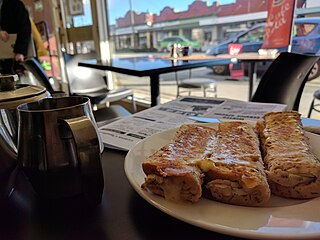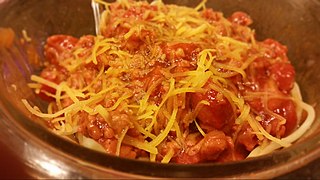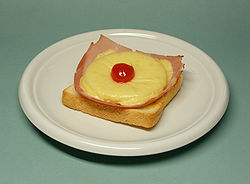Spam is a brand of processed canned pork and ham made by Hormel Foods Corporation. It was introduced in 1937 and gained popularity worldwide after its use during World War II. By 2003, Spam was sold in 41 countries on six continents.

Pa amb tomàquet is a traditional food of Catalan, Aragonese and Balearic cuisine. Pa amb tomàquet is considered a staple of Catalan cuisine and identity. While considered a signature toast dish in the Catalan Countries, it is common in bars throughout the rest of Spain, where it is also known as pan tumaca.

A croque monsieur is a hot sandwich made with ham and cheese. The name comes from the French words croque ("crunch") and monsieur ("gentleman").

An open sandwich, also known as an open-face/open-faced sandwich, bread baser, bread platter or tartine, consists of a slice of bread or toast with one or more food items on top. It has half the amount of bread of a typical closed sandwich.

Hawaiian pizza is a pizza originating in Canada, traditionally topped with pineapple, tomato sauce, cheese, and either ham or bacon.

A schnitzel is a thin slice of meat. The meat is usually thinned by pounding with a meat tenderizer. Most commonly, the meat is breaded before frying. Breaded schnitzel is popular in many countries and is made using veal, pork, chicken, mutton, beef, or turkey. Schnitzel is very similar to the dish escalope in France and Spain, panado in Portugal, tonkatsu in Japan, cotoletta in Italy, kotlet schabowy in Poland, milanesa in Latin America, chuleta valluna in Colombia, chicken chop in Malaysia, and chicken-fried steak and pork tenderloin of the United States.

A cheese roll is a New Zealand snack food similar to Welsh rarebit, but created by covering a slice of bread in a prepared filling consisting mainly of grated or sliced cheese, and then rolling it into a tube shape before toasting. Cheese rolls are a very popular food in Otago and Southland Region, where they are commonly found as a menu item at cafeterias and similar food outlets, and uncommonly referred to as southern sushi. They are one of a small number of recipes which are specific to only one of New Zealand's two main islands.

A zapiekanka is a toasted open-face sandwich made of a sliced baguette or other long roll of bread, topped with sautéed white mushrooms, cheese and sometimes other ingredients such as ham. Served hot with ketchup, it has been a popular street food in Poland since the 1970s.

Uruguayan cuisine is a fusion of cuisines from several European countries, especially of Mediterranean foods from Spain, Italy, Portugal and France. Other influences on the cuisine resulted from immigration from countries such as Germany and Scotland. Uruguayan gastronomy is a result of immigration, rather than local Amerindian cuisine, because of late-19th and early 20th century immigration waves of, mostly, Italians. Spanish influences are abundant: desserts like churros, flan, ensaimadas yoo (Catalan sweet bread), and alfajores were all brought from Spain. There are also all kinds of stews known as guisos or estofados, arroces, and fabada. All of the guisos and traditional pucheros (stews) are also of Spanish origin. Uruguayan preparations of fish, such as dried salt cod (bacalao), calamari, and octopus, originate from the Basque and Galician regions, and also Portugal. Due to its strong Italian tradition, all of the famous Italian pasta dishes are present in Uruguay including ravioli, lasagne, tortellini, fettuccine, and the traditional gnocchi. Although the pasta can be served with many sauces, there is one special sauce that was created by Uruguayans. Caruso sauce is a pasta sauce made from double cream, meat, onions, ham and mushrooms. It is very popular with sorrentinos and agnolotti. Additionally, there is Germanic influence in Uruguayan cuisine as well, particularly in sweet dishes. The pastries known as bizcochos are Germanic in origin: croissants, known as medialunas, are the most popular of these, and can be found in two varieties: butter- and lard-based. Also German in origin are the Berlinese known as bolas de fraile, and the rolls called piononos. The facturas were re-christened with local names given the difficult German phonology, and usually Uruguayanized by the addition of a dulce de leche filling. Even dishes like chucrut (sauerkraut) have also made it into mainstream Uruguayan dishes.

The ham sandwich is a common type of sandwich. The bread may be fresh or toasted, and it can be made with a variety of toppings including cheese and vegetables like lettuce, tomato, onion or pickle slices. Various kinds of mustard and mayonnaise are also common.

Cheese on toast is made by placing sliced or grated cheese on toasted bread and melting it under a grill. It is popular in the United Kingdom, Ireland, Australia, New Zealand, the Caribbean, and in African countries.

The cheese dream is an open-faced version of the American grilled cheese sandwich made with bread and cheese; it is cooked with either oil, margarine, or butter. Other ingredients such as bacon, avocado, pineapple, eggs, or sliced tomato can be optionally added to the open-faced sandwich as well.

Breaded cutlet or braised cutlet is a dish made from coating a cutlet of meat with breading or batter and either frying or baking it.

Filipino spaghetti is a Filipino adaptation of Italian spaghetti with Bolognese sauce. It has a distinctively sweet sauce, usually made from tomato sauce sweetened with brown sugar and banana ketchup. It is typically topped with sliced hot dogs or smoked longganisa sausages, giniling, and grated cheese. It is regarded as a comfort food in Philippine cuisine. It is typically served on almost any special occasion, especially on children's birthdays.














